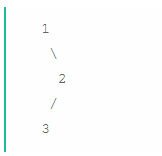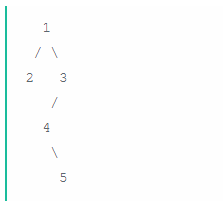二叉樹遍歷(中序)(遞迴+非遞迴)
阿新 • • 發佈:2018-12-16
Binary Tree Inorder Traversal(二叉樹中序遍歷)
Given a binary tree, return the inorder traversal of its nodes’ values.
For example:
Given binary tree{1,#,2,3},

return[1,3,2].
Note: Recursive solution is trivial, could you do it iteratively?
confused what"{1,#,2,3}"means? > read more on how binary tree is serialized on OJ.
OJ’s Binary Tree Serialization:
The serialization of a binary tree follows a level order traversal, where ‘#’ signifies a path terminator where no node exists below.
Here’s an example:

The above binary tree is serialized as"{1,2,3,#,#,4,#,#,5}".
遞迴思想
思路
中序遍歷的遞迴思想實現。
程式碼
vector<int> inorderTraversal(TreeNode *root) { // 二叉樹中序遍歷 vector<int > v; if(root == NULL)return v; inorder_help(root, v); return v; } void inorder_help(TreeNode *root, vector<int > &v) { if(!root)return; inorder_help(root->left, v); v.push_back(root->val); inorder_help(root->right, v); }
非遞迴思想
思路
用非遞迴模擬二叉樹的中序遍歷,思路是:優先遍歷根節點的左孩子結點,放入一個棧中,遍歷到底;然後從棧中取結點,棧的特點是後進先出,從最後的節點開始加入vector陣列;接著遍歷該結點的右孩子結點,把該孩子結點當作根節點遍歷左孩子結點。
實現的思想和遞迴是一樣的,就是根據中序遍歷的特點,即:
inorder(root -> left);
get(root -> val);
inorder(root -> right);
程式碼
vector<int> inorderTraversal(TreeNode *root) { vector<int > v; stack<TreeNode* > s; TreeNode *node = root; while(!s.empty() || node!=NULL) { while(node != NULL) { s.push(node); node = node->left; } node = s.top(); s.pop(); v.push_back(node->val); node = node->right; } return v; }
以上。
版權宣告:本文為博主原創文章,轉載請註明出處。
個人部落格地址:https://yangyuanlin.club
歡迎來踩~~~~
